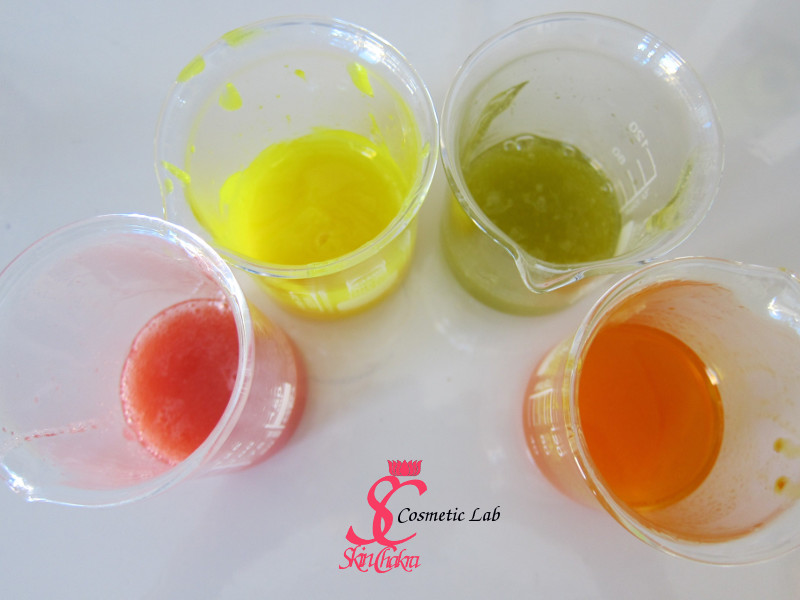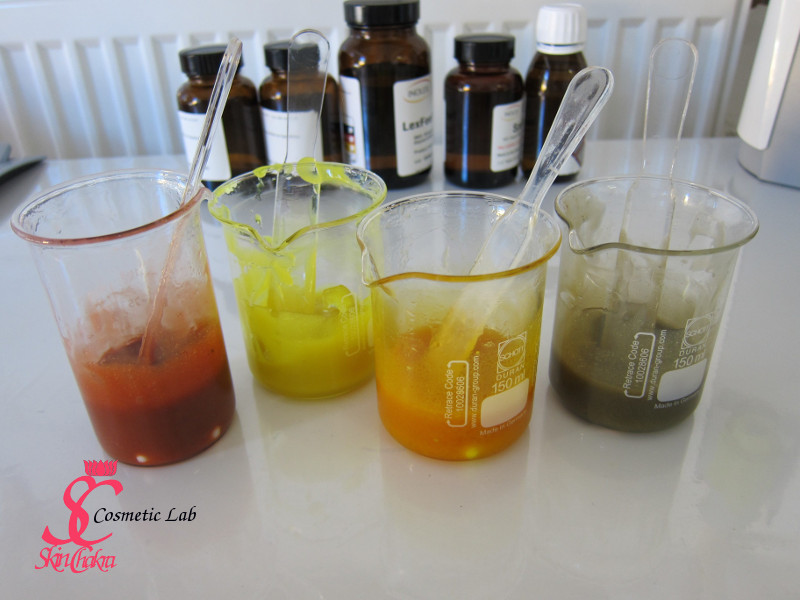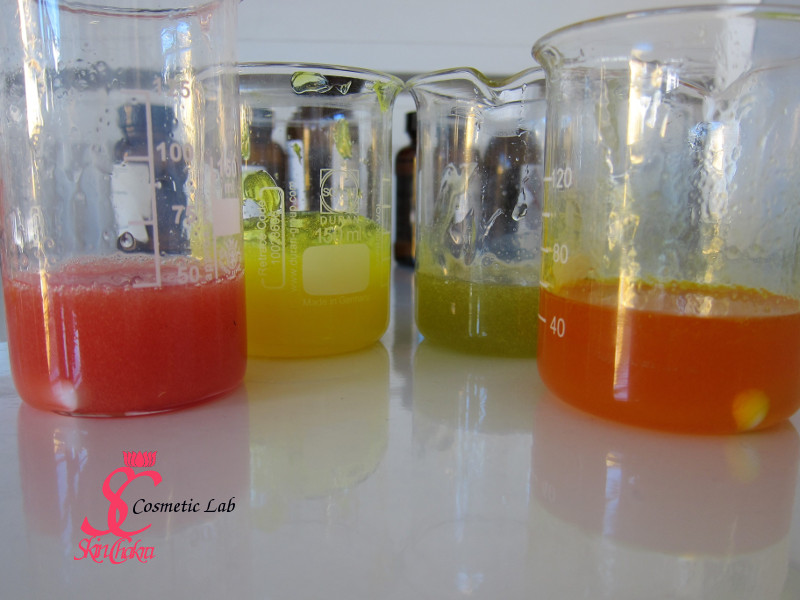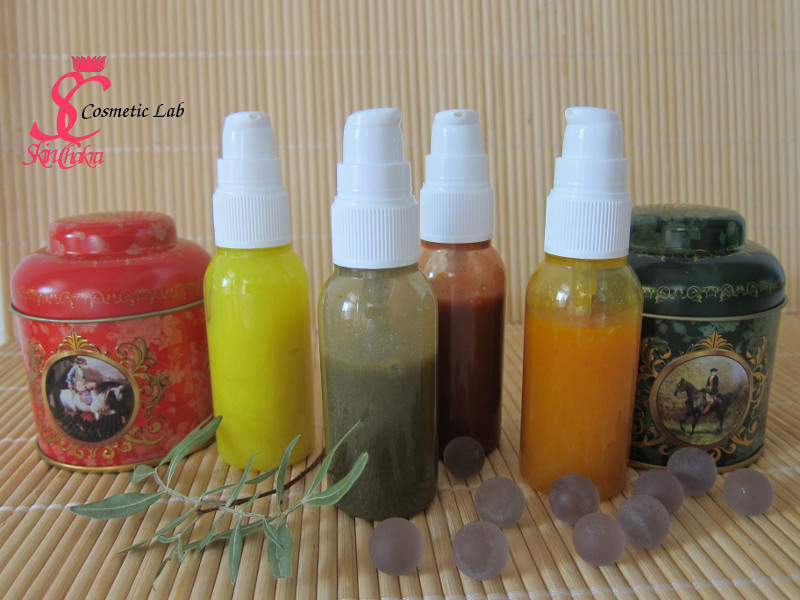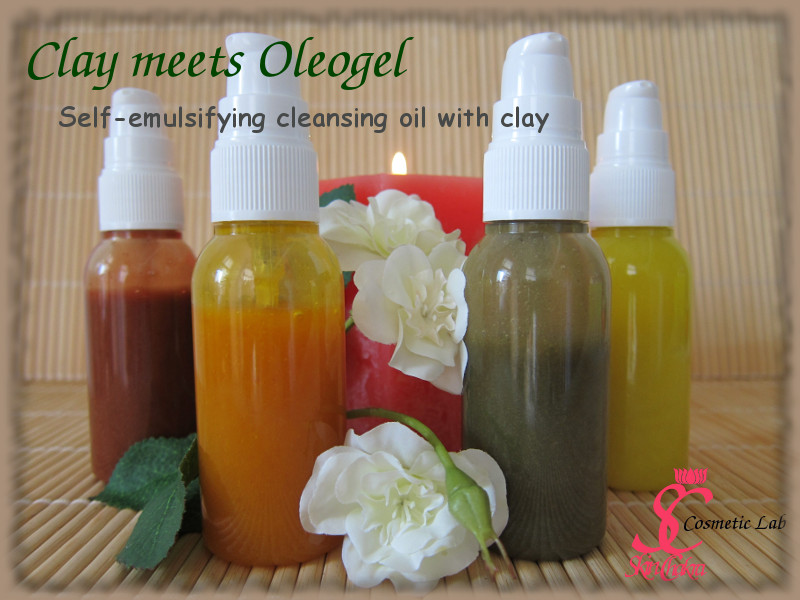
Sonntag, 11. September 2016
How to make a self-emulsifying and self-preserving clay cleansing gel
Clays are so popular and so effective in hair & skin care yet they are notoriously challenging for preservation. Mainstream takes it easy and loads the products containing clays with alcohol, phenoxyethanol and even formaldehyde donours to effectively preserve water containing products. In "natural & organic" cosmetics where we try to avoid alcohol and certainly are determined to avoid phenoxyethanol and co. we usually try to prepare multiple container products where the water phase and the clay containing dry phase are sold separately and it is the customer who adds water to the clay just before application.
This is a very practical way to avoid conventional and sensitizing preservatives yet offer natural & safe products. The drawbacks are:
- the hassle of dosage and the possibility that one phase is always sooner finished than the other
- the time consuming preparation (even if it is just a few seconds) for lazy and busy consumer (including myself)
To create a medium way, having clays in a ready to use product yet avoid any risk of contamination, there is another way and it is preparing self-preserving and waterless products. In a previous post we've prepared a clay containing cleansing balm combining all the benefits of those wonderful butters and oils with clays and just to improve the skin feel and add a phospholipid touch to the product, we've added some lecithin to avoid any greasiness and stickiness after rinsing.
In this post we're going to show you how to blend clays in a self-emulsifying oleogel to make self-preserving, self-emulsifying clay cleansers in 4 ways (well in 4 different variations).
If you're not yet familiar with oleogels and the colourful masks we prepared in Augist please go back to this post to be forwarded to the previous posts about oleogel principles. If you have already made some oleogels, follow me through this tutorial to prepare these cute oleogel cleansers with clays.
The principle is quite easy (when you know how to make an oleogel), you just need to add the clay at the end and that's it. You shall only keep in mind that your oleogel should not be too runny or too hard, just adjust the viscosity so that the clay remains suspended but the gel is applicable from a pump (to avoid any chances of contamination)
Let's go to the recipes
1- Soothing Hemp oil -green clay oleogel cleanser
| Phase A | |
| Dermofeel G5O | 6.0% |
| Glycerine 99,5% | 30.0% |
| Phase B | |
| Organic Hemp seed oil | 35.7% |
| Organic Camelina seed oil | 17.0% |
| Chamomile infused organic jojoba oil | 2.5% |
| Calendula infused organic castor oil | 2.5% |
| Lavender infused organic baobab oil | 2.0% |
| Tocopherol | 0.5% |
| Alpha-bisabolol | 0.2% |
| Rosemary CO2 extract | 0.1% |
| Organic patchouli EO | 0.2% |
| Organic lime EO | 0.2% |
| Organic fennel EO | 0.1% |
| Phase C | |
| Green clay | 3.0% |
2- Carotenoid rich-kaolin cleansing oleogel
| Phase A | |
| Dermofeel G5O | 6.0% |
| Glycerine 99,5% | 32.0% |
| Phase B | |
| Carrot root infused organic jojoba oil | 19.7% |
| Organic perilla seed oil | 10.0% |
| Organic peanut oil | 5.0% |
| Lavender infused organic castor oil | 5.0% |
| Chamomile infused organic jojoba oil | 5.0% |
| Wild crafted buriti oil | 3.0% |
| Turmeric infused organic jojoba oil | 3.0% |
| Organic evening primrose oil | 2.0% |
| St John's worth infused organic almond oil | 2.0% |
| Tocopherol | 0.5% |
| Alpha-bisabolol | 0.2% |
| Rosemary CO2 extract | 0.1% |
| Sandalwood infused organic castor oil | 3.0% |
| Organic grapefruit EO | 0.4% |
| Organic amyris EO | 0.1% |
| Phase C | |
| Kaolin clay | 3.0% |
3- Baobab oil-pink clay cleansing oleogel (refatting, mild cleansing)
| Phase A | |
| Dermofeel G5O | 6.0% |
| Glycerine 99,5% | 33.0% |
| Phase B | |
| Alkanet infused organic baobab oil | 20.0% |
| Organic perilla seed oil | 11.7% |
| Organic poppy seed oil | 5.0% |
| Organic peanut oil | 5.0% |
| Calendula infused organic jojoba oil | 5.0% |
| Rose infused organic castor oil | 5.0% |
| Chamomile infused organic jojoba oil | 3.0% |
| St john's worth infused organic almond oil | 2.0% |
| Tocopherol | 0.5% |
| Alpha-bisabolol | 0.2% |
| Rosemary CO2 extract | 0.1% |
| Organic blood orange EO | 0.4% |
| Organic manuka EO | 0.1% |
| Phase C | |
| Pink clay | 3.0% |
4- Anti inflammatory turmeric and yellow clay cleansing oleogel
| Phase A | |
| Dermofeel G5O | 6.0% |
| Glycerine 99,5% | 30.0% |
| Phase B | |
| Turmeric infused organic jojoba oil | 20.7% |
| Organoc camelina seed oil | 15.0% |
| Organic perilla seed oil | 10.0% |
| Calendula infusion in organic castor oil | 5.0% |
| Chamomile infusion in organic jojoba oil | 5.0% |
| St john's worth infusion in organic almond oil | 2.0% |
| Squalane | 2.0% |
| Tocopherol | 0.5% |
| Alpha-bisabolol | 0.2% |
| Rosemary CO2 extract | 0.1% |
| Organic cedarwood EO | 0.4% |
| Organic cypress EO | 0.1% |
| Phase C | |
| French yellow clay | 3.0% |
Procedure (for all 4 variations):
1- Blend glycerine and Dermofeel G5O @RT. This is easily done by a spatula or glass rod.
2- Blend all ingredients in phase B @RT. very slowly (and this is the most important part of the whole procedure) add phase B to phase A in small aliquots. Blend after each addition to completely incorporate the oil. Do not let any oil pool to be formed. If the oil is not correctly incorporated you have to discard the whole batch because you'll end up with a 2 phasic something that is neither an oil nor a gel. Try to avoid any agitation. You don't want any bubbles to get trapped in your gel.
3- After all of the oil phase is added and incorporated stop blending. The gel might look a little bit turbid but it is because of some air bubbles.
4- Slowly and trying to avoid any agitation add the clay in small aliquots and blend. The beautiful bright colour of the oleogel turns a little bit turbid but this is the price we pay for the efficacy of the clays.
5- Fill the gel in a pretty container and voila, this is your oleogel mask full of amazing nutritive ingredients.
We recommend filling th eoleogel in a pump bottle and not a jar. You don't want to risk any contamination by filling the cleansing oleogel in a jar and then accidentally adding water to it. If the viscosity is too high for a pump bottle, reduce the viscosity by increasing the glycerine content.
It's your turn now to create some amazing masks. Feel free to send us your photos and comment either per mail or to our Facebook page. If you post any photos on Instagram, don't forget to tag @SkinChakra.
BeHappy and have fun
